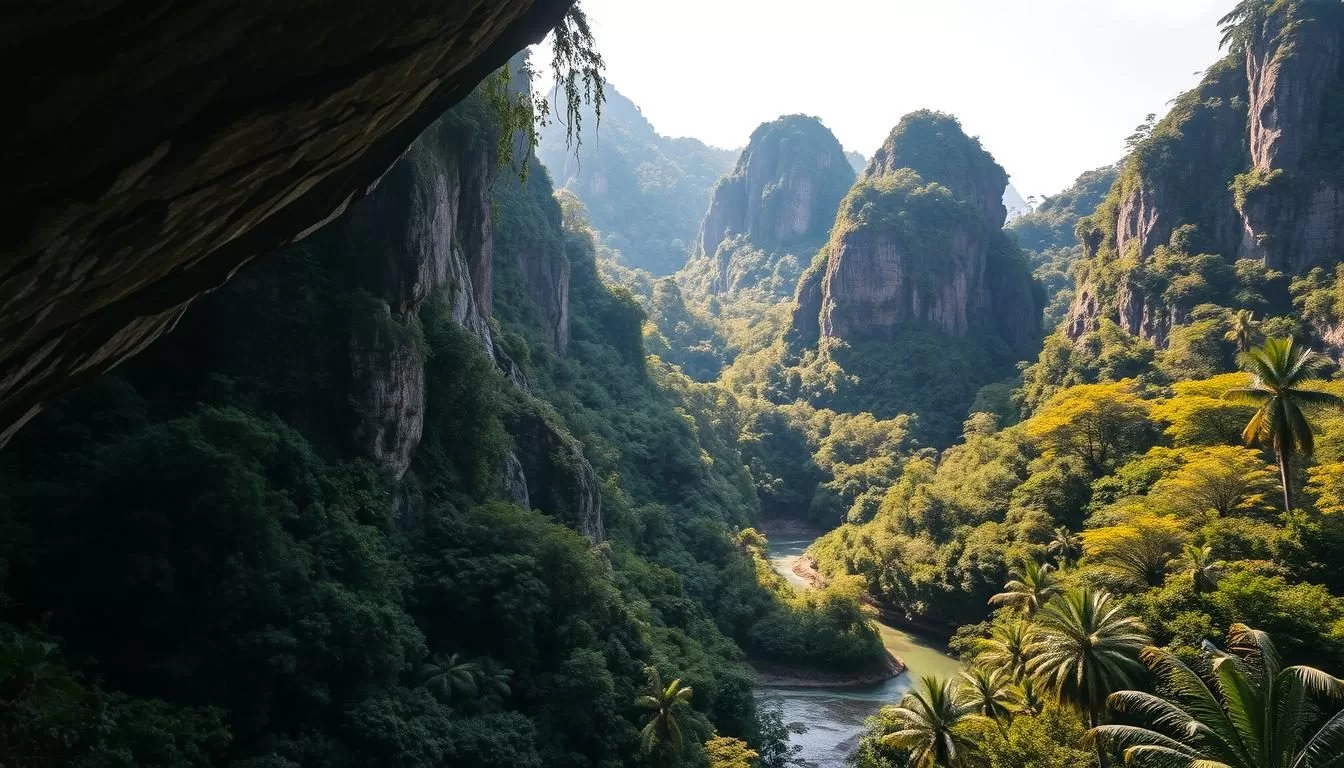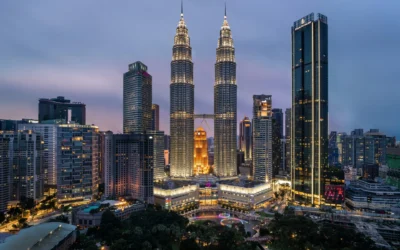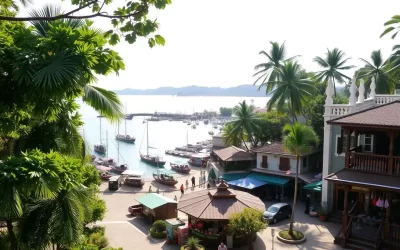✓ Accommodations✓ Flights✓ Rental Cars
Imagine stepping into a world of breathtaking natural beauty, where massive cave systems and ancient rainforests await your exploration. Located in Malaysia, this UNESCO World Heritage site is a treasure trove of biodiversity and unique landscapes.
As you venture into this 529-square-kilometer national park, you’ll be struck by its sheer scale and untouched beauty. The park’s caves and rainforest ecosystems are home to a vast array of flora and fauna, making it a haven for nature lovers and adventure seekers.
With its unique features and diverse wildlife, this park stands out from typical parks in Malaysia. Get ready to experience the top picks for activities and create unforgettable memories in this incredible destination.
Discovering Gunung Mulu National Park
With its rich biodiversity and unique geological features, Gunung Mulu National Park is a fascinating place to explore. This park is not just any ordinary national park; it’s a UNESCO World Heritage Site that has met all four criteria for listing, a feat that underscores its natural significance.
Gunung Mulu National Park, also known as Mulu National Park or Mulu Caves National Park Sarawak, is one of the top places to visit in Sarawak. The park’s limestone cave systems and 60-million-year-old rainforest make it a haven for nature lovers and adventure seekers alike.
UNESCO World Heritage Status
The park’s designation as a UNESCO World Heritage Site is a testament to its outstanding universal value. This status was awarded due to the park’s unique natural beauty and its importance as a habitat for a wide range of flora and fauna. The park’s caves, mountains, and rainforests are not only breathtaking but also provide a habitat for numerous species that are found nowhere else on Earth.
Geological Significance
The geological features of Gunung Mulu National Park are truly remarkable. The park is home to massive limestone caves that began forming approximately 5 million years ago. The unique side-by-side limestone and sandstone mountains were created by sideways movements of the Earth’s crust, resulting in a landscape that is both beautiful and scientifically significant.
Flora and Fauna
The park’s 60-million-year-old rainforest is home to an incredible array of biodiversity. The isolated ecosystem has allowed unique flora and fauna to evolve, including rare plant species and diverse wildlife. Visitors to the park can expect to see a wide range of species that are not found in other parts of the world.
| Feature | Description | Significance |
|---|---|---|
| UNESCO World Heritage Status | Awarded due to the park’s natural beauty and biodiversity | Recognizes the park’s universal value |
| Geological Features | Massive limestone caves and unique mountain formations | Scientifically significant and breathtakingly beautiful |
| Flora and Fauna | Incredible array of biodiversity, including rare species | Provides a habitat for unique and diverse wildlife |
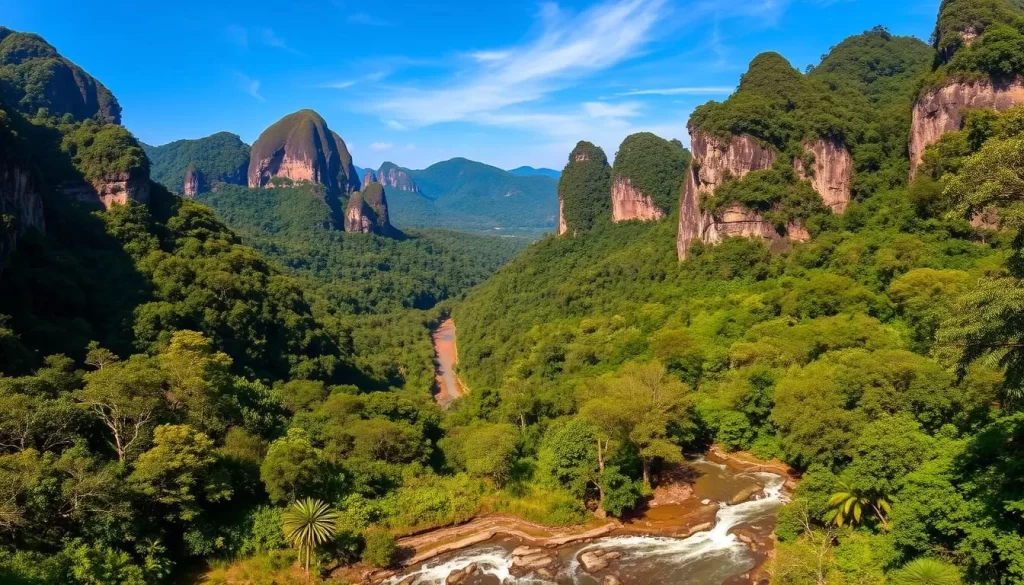
How to Get to Gunung Mulu National Park
If you’re planning to visit Gunung Mulu National Park, you’ll be flying in from Miri, Kuching, or Kota Kinabalu. The only practical way to reach the park is by air, although technically, you can hike in, which involves boats and jeeps, but this is not recommended.
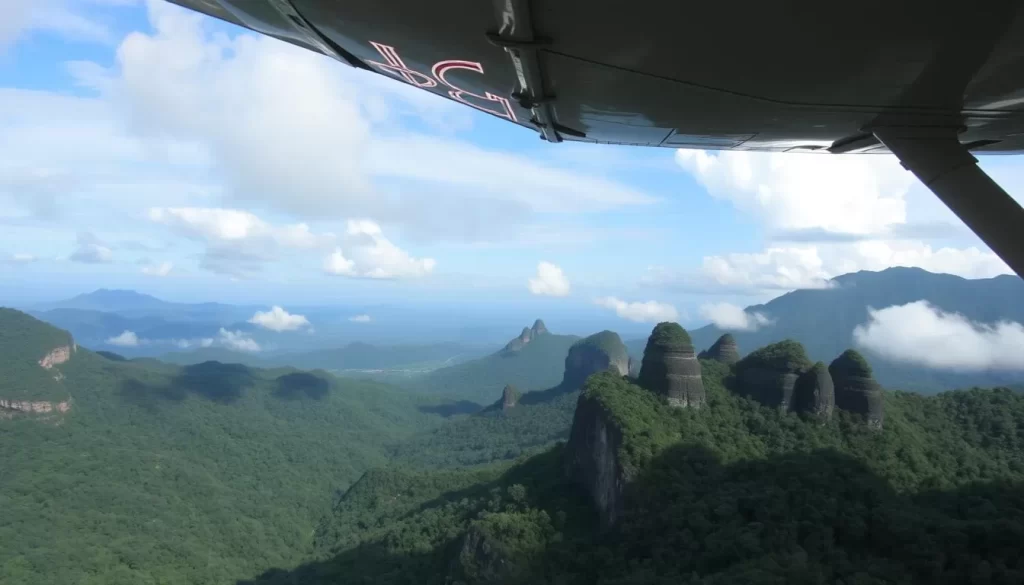
Flying from Miri to Mulu
The gateway to Mulu National Park is via Miri in North East Sarawak. MAS Wings, a subsidiary of Malaysia Airlines, operates flights from Miri to Mulu. The direct flight takes just 30 minutes, with about 15 flights per week on this route.
Flying from Kuching to Mulu
You can also fly from Kuching in Sarawak to Mulu. This flight takes 1 hour and 35 minutes, with seven direct flights per week. While this saves time, it is more expensive due to the airline used.
Flying from Kota Kinabalu to Mulu
If you’re visiting Sabah and want to fly to Mulu from there, you can take a flight from Kota Kinabalu, which takes 55 minutes. However, there are only three flights per week on this route.
Airport Transfers
The local community of Mulu provides reliable and affordable airport transfers costing 5RM (£0.90) per person to the hotels and lodges around the national park. You can also walk from the airport to your accommodation or the national park, which takes about 15-20 minutes.
Best Time to Visit Mulu National Park
Unlike other parts of Malaysia, Gunung Mulu National Park has a relatively consistent temperature throughout the year, making it a potential destination at any time.

Weather Considerations
The park’s rainforest environment means that rain is likely during your Mulu trip, regardless of when you plan your visit. If you prefer drier conditions, consider visiting between July and September, but be prepared for hotter temperatures that can make activities more strenuous.
Peak vs. Off-Peak Seasons
July to September is considered the peak season due to slightly drier weather, necessitating advance booking for accommodations and activities. In contrast, visiting during the off-peak seasons can offer a more authentic experience with fewer crowds and potentially lower prices. Plan your trip according to your preferences regarding weather, crowds, and activity availability.
Gunung Mulu National Park, Malaysia: Best Things to Do – Top Picks
Gunung Mulu National Park offers a diverse range of activities that cater to different interests and fitness levels. From gentle forest bathing to epic Borneo rainforest adventures, you can choose from a variety of experiences that make your visit unforgettable.
Overview of Available Activities
The park is renowned for its show caves, night walks, and canopy walks, which are perfect for those seeking gentler explorations. For the more adventurous, activities like adventure caving, the Pinnacles trek, and trekking to Mulu Summit are available.
All activities require a guide, and you can book through the national park or an outside service. It’s worth noting that local Berawan guides offer the same experiences at similar prices, with the added benefit of directly supporting the local community.
Tour Booking Information
Booking a tour is straightforward. You can book directly through the park headquarters or with local private guides. It’s recommended to book in advance for popular activities due to limited spaces.
When booking, consider the difficulty level of the activity and your fitness level. Some activities, like adventure caving and multi-day treks, require a good level of physical fitness.
Activity Difficulty Levels
Activities in Gunung Mulu National Park range from easy to challenging. Easy activities include show cave tours and canopy walks, while challenging activities include adventure caving and multi-day treks.
| Activity | Difficulty Level | Duration |
|---|---|---|
| Show Cave Tour | Easy | 1-2 hours |
| Canopy Walk | Easy | 1-2 hours |
| Adventure Caving | Challenging | 4-6 hours |
| Pinnacles Trek | Challenging | 3 days |
To create a well-rounded itinerary, consider balancing different types of activities. For example, you could pair a challenging hike with a more leisurely walk or cave tour.
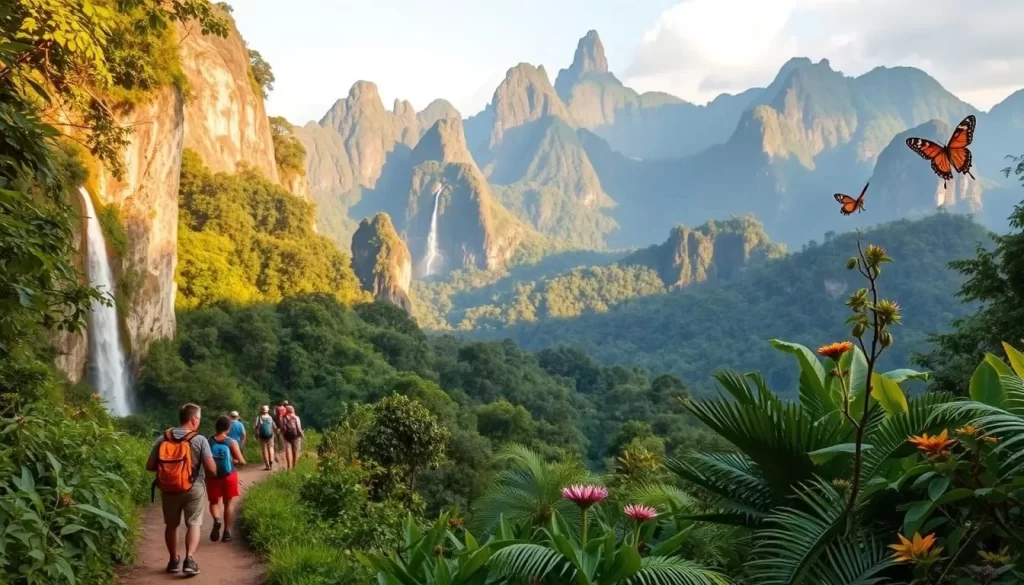
Exploring the Show Caves
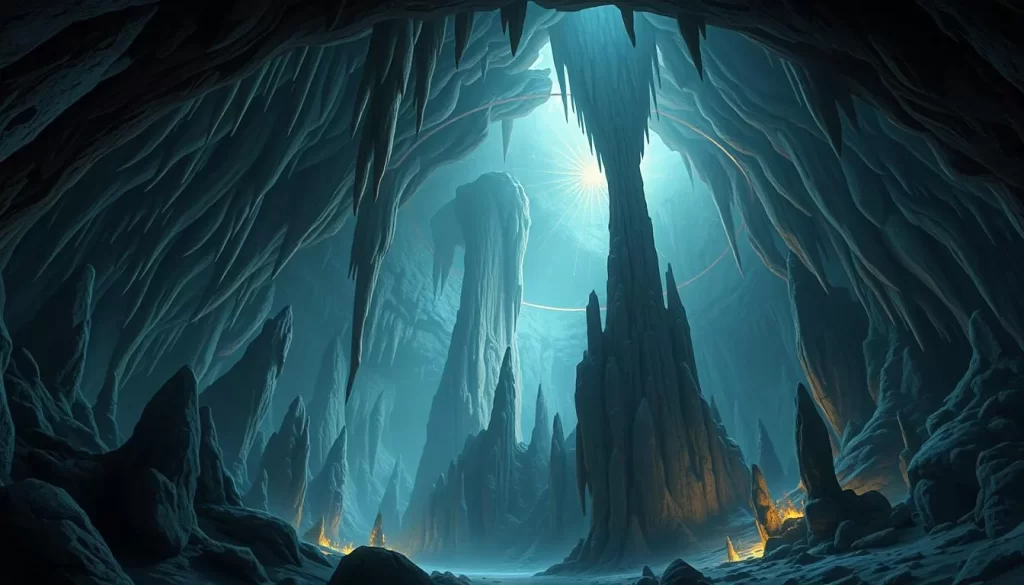
As you explore the depths of Mulu National Park, you’ll discover the breathtaking beauty of its show caves. The park is home to four spectacular show caves: Deer Cave, Lang Cave, Wind Cave, and Clearwater Cave. Each cave offers a unique experience, showcasing the natural wonders of the park.
Deer Cave – World’s Largest Cave Passage
Deer Cave is the largest show cave at Mulu Caves in Malaysia and boasts the world’s largest cave passage, measuring over two kilometers long and 174 meters high. As you walk about 800 meters inside, you’ll witness many fascinating formations, including the Adam and Eve shower heads and the Garden of Eden. The cave is home to millions of bats, and while the guano (bat poo) can be overwhelming, the boardwalk and metal paths ensure you can navigate through without stepping on it.
Lang Cave – Intricate Formations
Lang Cave, on the other hand, is smaller but equally impressive, featuring intricate stalagmites, stalactites, rimstone pools, and limestone shawls. The cave’s prettier and more intricate formations provide a beautiful contrast to the massive Deer Cave. The walk to Lang Cave is about a 3.8-kilometer journey from the park headquarters on a well-maintained boardwalk, taking about an hour with a guide.
Wind Cave – King’s Chamber
The tour to Wind Cave and Clearwater Cave begins with a scenic longboat ride through the rainforest, followed by a stop at a Penan market where you can purchase local handicrafts. Wind Cave is named for the cool winds that blow through it, particularly felt at the narrowest part of the walk. The King’s Chamber is a highlight, filled with impressive stalagmites and columns. The walk is manageable, with some steps and boardwalks.
Clearwater Cave – Underground River
Clearwater Cave is part of one of the world’s largest cave systems, stretching 220 kilometers. The cave is named after the crystal-clear river that runs through it. You’ll see a large cavern and experience the roar of the river as it shapes the cave. The walk involves quite a few stairs, including steep ones with a rope, but it’s a circular route, so there’s no backtracking. After the tour, you can swim in the outside lagoon to cool down, surrounded by pristine rainforest.
The show caves of Mulu National Park offer an unforgettable experience, with each cave presenting unique features and formations. Understanding the physical requirements for each cave tour will help you prepare appropriately, ensuring a safe and enjoyable visit.
Witnessing the Bat Exodus
One of the most spectacular experiences at Mulu National Park is witnessing the Bat Exodus. The massive Deer Cave is home to 2.5 to 3.5 million bats of 12 different species, creating a breathtaking spectacle as they exit the cave in the evening.
Best Viewing Times
The timing of the bat exodus is somewhat unpredictable, typically occurring between 5:30 and 6:30 PM, but sometimes as early as 4:00 PM. It’s essential to be prepared and flexible when planning to witness this event, as the time of the exodus can vary.
Bat Observatory Area
The Bat Observatory area is specifically designed to provide an optimal viewing experience. Visitors can watch the bat exodus either as part of the Deer and Lang Caves tour or independently by walking to the observatory. The observatory is about a 45-minute walk from Park Headquarters, and it’s advisable to bring a torch for the return journey.
| Viewing Option | Description | Duration/Distance |
|---|---|---|
| Guided Tour | Part of Deer and Lang Caves tour | Varies |
| Independent Visit | Walk to Bat Observatory | 45 minutes, 3 km |
Adventure Caving Experiences
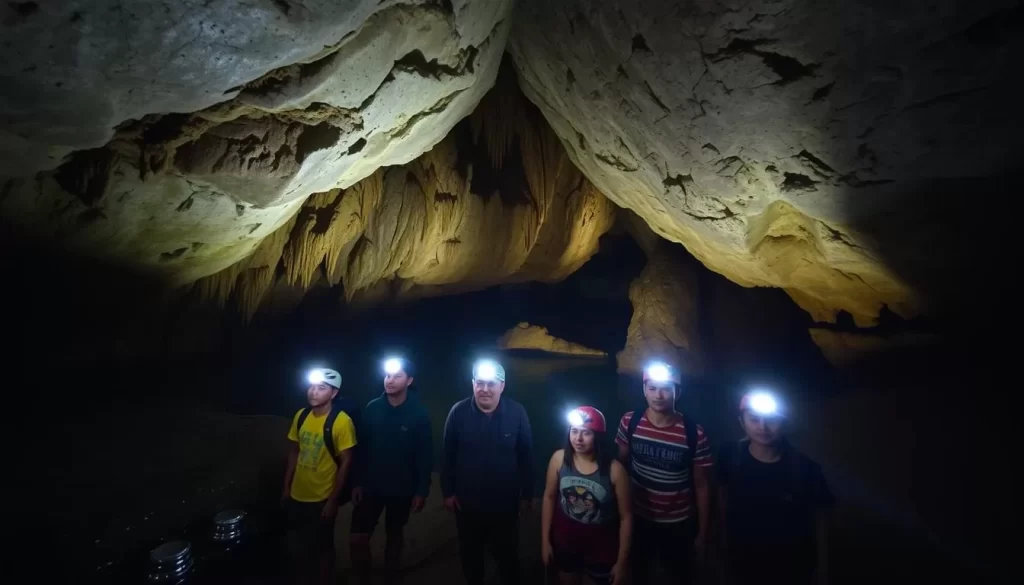
For the more adventurous travelers, Gunung Mulu National Park offers an array of exciting caving experiences that go beyond the usual show caves. These adventure caving experiences are designed for those who are willing to venture into the unknown and explore the park’s hidden underground world.
The park’s adventure caves are categorized into beginner, intermediate, and advanced levels, ensuring that there’s something for everyone. Whether you’re a seasoned caver or just starting out, you’ll be able to find a tour that suits your skill level.
Racer Cave Experience
The Racer Cave experience is one of the most popular adventure caving options in Mulu. This experience involves swimming, climbing, and navigating through diverse underground passages, making it an adrenaline-packed adventure.
You’ll be provided with special equipment, including harnesses, helmets, and headlamps, to ensure your safety while exploring the cave.
Other Adventure Caving Options
In addition to the Racer Cave experience, Mulu offers other adventure caving options that cater to different interests and skill levels. These include trips to less-visited sections of the show caves and specialized expeditions for experienced cavers.
You may encounter unique cave wildlife, such as racer snakes and unusual insects adapted to the cave environment, during your adventure caving experience.
It’s essential to book your adventure caving tour well in advance, as they often fill up months ahead, especially during peak season.
Walking the Mulu Canopy Skywalk
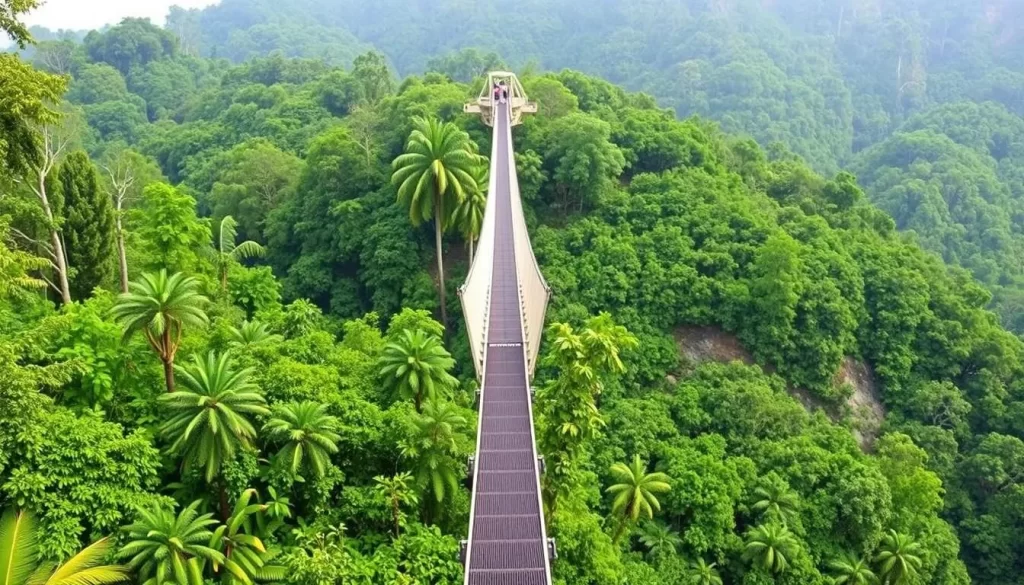
Experience the thrill of walking on the Mulu Canopy Skywalk, a marvel of engineering suspended high above the forest floor. The canopy walk is a 420-meter-long walkway that is anchored to trees and is reputed to be one of the longest tree-based canopy walks in the world.
This activity can only be done as part of a guided tour, with groups limited to eight people, making advance booking essential. The tour involves approximately six kilometers of walking round-trip on boardwalks to reach and return from the canopy walk.
What to Expect
During the canopy walk, you can expect to be immersed in the rainforest canopy while crossing suspended bridges. The walkway is designed to allow you to cross over rivers twice, offering spectacular views of the surrounding ecosystem.
There are information boards along the walk to help you identify and understand the diverse plant and animal life in the canopy ecosystem. A guide will accompany you throughout the tour, providing additional insights and information.
Wildlife Spotting Opportunities
From the elevated vantage point of the canopy walk, you have the opportunity to spot various bird species and canopy-dwelling creatures. The early morning tour, around 7 AM, is particularly recommended when temperatures are cooler and wildlife is more active.
The Mulu Canopy Skywalk is an unforgettable experience that allows you to explore the rainforest from a new height. With its unique design and stunning views, it is an activity that you won’t want to miss when visiting Mulu National Park.
Trekking to The Pinnacles

For those who dare to take on the challenge, the Pinnacles Trek offers an adventure like no other. Located in Gunung Mulu National Park, this 3-day/2-night trekking adventure is rated as an extreme activity due to the challenging climb involved.
The Pinnacles are a collection of 50-meter high jagged limestone spires on the slopes of Mount Api. This trek is not for beginners; it requires a great level of fitness and climbing ability. If you’re afraid of heights, this trek is not for you.
Day 1: Boat Ride and Trek to Camp 5
The journey begins with a scenic boat ride on the Melinau River, where you can optionally take the Clearwater Cave tour. You then continue to Kuala Litut, starting the 9-kilometer hike to Camp 5. This initial trek is relatively easy and flat, allowing you to acclimate to the surroundings.
Camp 5 is a forest shelter with basic accommodations, including raised platforms with mats for sleeping, cold showers, toilets, and a self-catering kitchen. You need to bring your own food and bedding, although you can pay a deposit to borrow bedding from Park Headquarters.
Day 2: The Challenging Climb
The second day starts early at 6:30 AM with a challenging climb. The 2.4-kilometer ascent to the top involves a significant altitude rise of 1,200 meters, including the nearly vertical “Danger Zone” with 17 rope sections and ladders. This section takes 3-5 hours to climb.
The trek offers stunning views as it climbs through limestone forest and past pitcher plants and rare orchids. There are three checkpoints to ensure you return to camp in daylight. At the summit, you’ll have about an hour to enjoy the spectacular views before descending.
Day 3: Return Journey
On the third day, you’ll retrace your steps with a 9-kilometer walk back to Kuala Litut, followed by a boat ride back to Park Headquarters. This day is less strenuous but still requires a good level of fitness.
Proper preparation is key to a successful trek. Ensure you have the necessary gear, including appropriate clothing, footwear, and health and safety items.
Other Trails and Walks
Mulu National Park’s trails and walks provide an immersive experience into the park’s natural beauty. The park offers a range of activities for visitors to explore beyond the main attractions.
Night Walk
One of the most popular activities is the guided night walk, which takes place every evening around 7:00-7:30 PM. These walks last about 1.5 to 2 hours and offer the chance to see nocturnal wildlife such as tree frogs, spiders, and vine snakes. It’s advisable to bring a torch for better viewing. While guides enhance the experience, you can also undertake your own night walk after 8:00 PM, but ensure you inform someone of your plans.
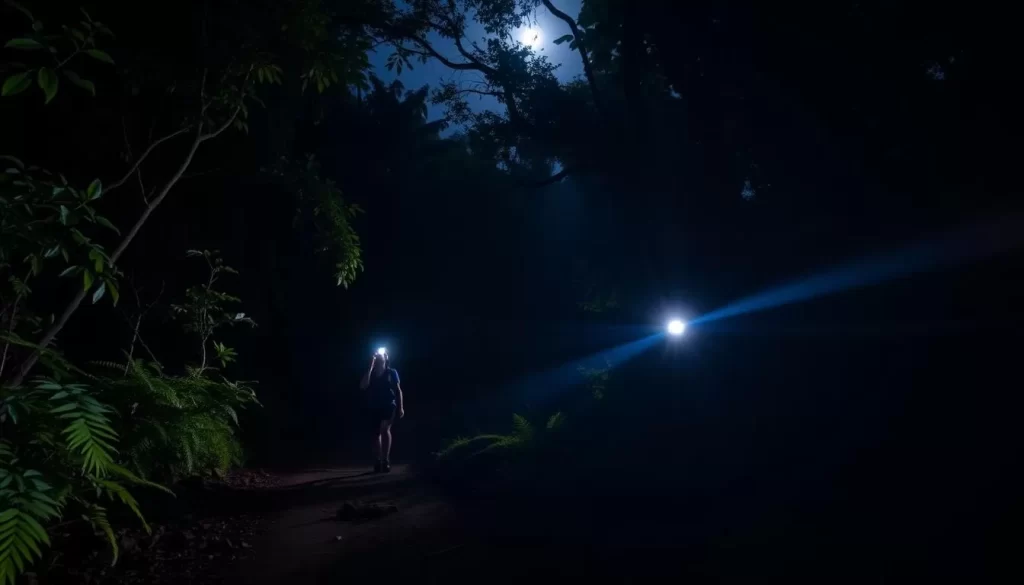
Botanical Heritage Trail
The Botanical Heritage Trail is a 1.5-kilometer circular path that can be walked without a guide. It features information boards about plant evolution and has resting spots, including a picturesque area by a waterway. This trail is easy and flat, mostly on boardwalk, making it suitable for all visitors.
Tree Top Tower
Just a 10-minute walk from Park Headquarters, the Tree Top Tower offers excellent birdwatching opportunities from its 30-meter height. The best times to visit are between 5:00-9:00 AM and 4:00-8:00 PM. While the tower is a free attraction, a RM50 deposit is required to borrow the key.
Paku Waterfall
For a more challenging walk, consider the 8-kilometer Paku Valley loop, which leads to Paku Waterfall where you can swim. The trail follows the Paku River and involves crossing streams, so it’s essential to register at Park Headquarters before embarking on this journey.
These trails and walks at Mulu National Park allow you to experience the rainforest ecosystem at your own pace, offering a diverse range of flora and fauna to discover.
Mulu Summit Trek
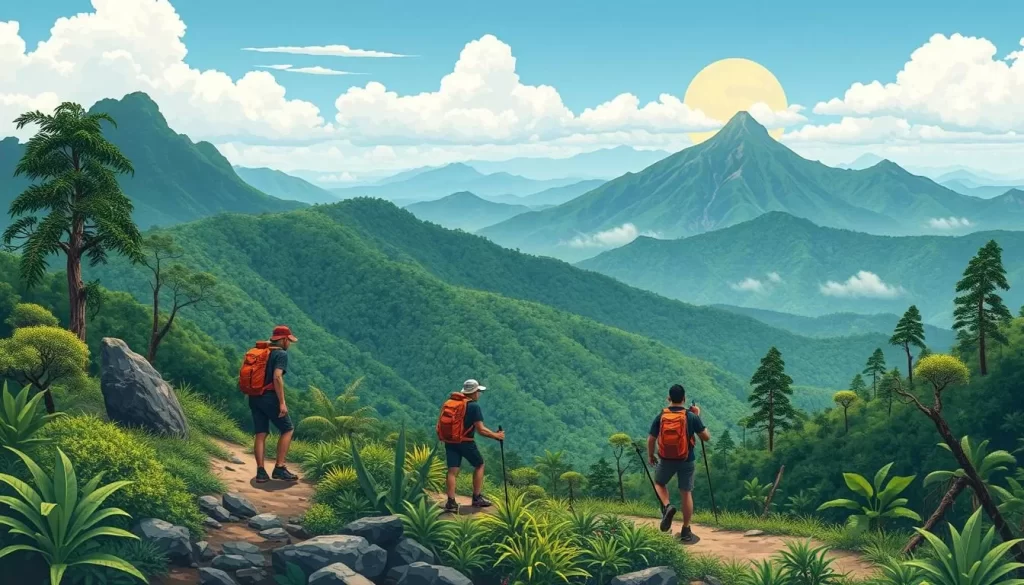
Embark on the ultimate adventure in Gunung Mulu National Park with the challenging 4-day/3-night Mulu Summit Trek. This trek is considered the most challenging guided experience available in the park, requiring excellent physical fitness and endurance as you hike to the top of Gunung Mulu (2,376 meters), the second-highest mountain in Sarawak.
The Mulu Summit Trek takes you through diverse ecosystems, from lowland rainforest to montane forest, and finally to mossy cloud forest near the summit. Along the way, you’ll have the opportunity to discover unique flora and fauna that can only be seen on this trek, including rare pitcher plants, orchids, and bird species that inhabit different elevation zones.
Prepare for the physical demands of the trek, including steep ascents, challenging terrain, and potentially difficult weather conditions. Camping arrangements are provided during this multi-day adventure, with some equipment provided and some to be brought by yourself. It’s essential to understand the booking requirements and timing considerations for this specialized trek, which requires advance planning and is only available at certain times of the year.
The spectacular panoramic views from the summit are truly breathtaking, extending across vast stretches of Borneo’s rainforest and even to the South China Sea on clear days. When planning your Mulu National Park adventure, consider whether this challenging trek or the Pinnacles Trek better suits your interests and abilities.
Where to Stay in Mulu
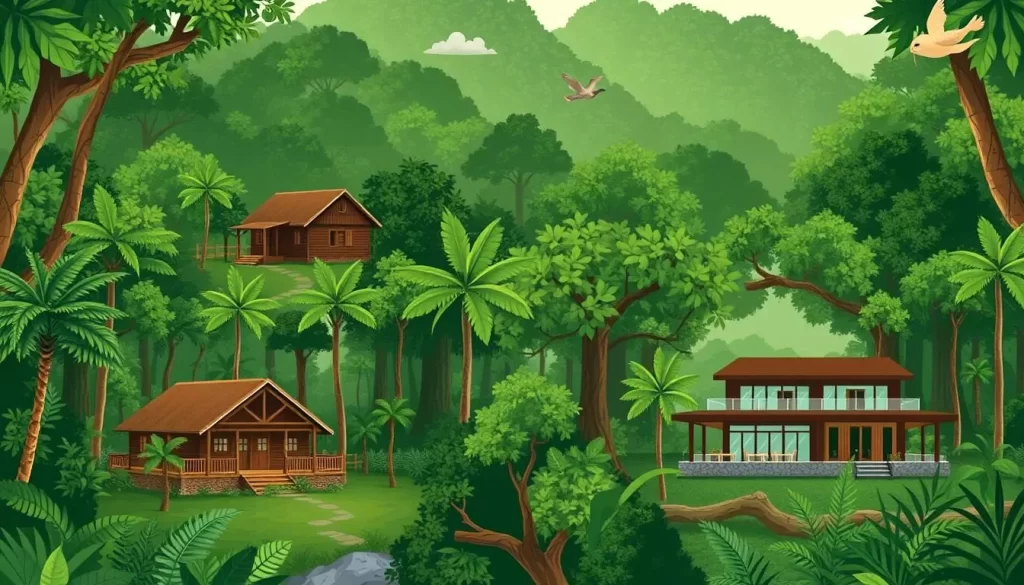
When planning your trip to Gunung Mulu National Park, choosing the right accommodation is crucial for a comfortable and enjoyable experience. The park offers various options to suit different budgets and preferences.
Mulu National Park HQ Accommodation
The Mulu National Park HQ accommodation is a convenient option, providing easy access to all activities within the park. You can choose from double rooms starting at 320RM ($83) per night, longhouse-style rooms with four single beds at 340RM ($88) per night, or dormitories costing 58RM ($15) per bed per night. All rooms include a daily set breakfast.
Mulu Marriott Resort and Spa
For a luxurious experience, the Mulu Marriott Resort and Spa is located just five minutes from the national park. The resort offers lavish cabin-style accommodation on stilts, modern amenities, a spa, swimming pool, and extensive dining options. A standard deluxe room starts at 515RM ($124) per night.
Budget Homestays and Lodges
For budget travelers, there are locally-run homestays and backpacker lodges in Mulu town, offering rooms for as little as 35RM ($8.50) per night, including breakfast. Options like the AA homestay and Mulu Village homestays are popular among budget-conscious travelers. However, be aware that most budget accommodations outside the park only have electricity for a few hours each evening.
In conclusion, Mulu National Park offers a range of accommodation options to suit various needs and budgets. Whether you prefer to stay within the park or in nearby Mulu town, you can find a suitable place to stay that enhances your overall experience.
Where to Eat in Mulu
As you explore the wonders of Mulu National Park, you’ll discover a range of dining options to fuel your adventures. The park and its surroundings offer a variety of eateries that cater to different tastes and budgets.
Mulu Cafe
Mulu Cafe, located at the Park Headquarters, is a convenient and reasonably priced option for meals. The cafe serves a variety of Malaysian and Western dishes. Breakfast options include traditional Malaysian roti canai with dhal, pancakes, and Western staples like eggs and toast. Vegetarian options are also available, such as vegetable coconut curry and paku jungle fern with ginger and garlic.
Good Luck Cave-Fe Mulu
For a more affordable dining experience, Good Luck Cave-Fe Mulu is just outside the park. They serve a range of Malaysian dishes like laksa, tom-yum soup, and nasi goreng, priced between 10-18RM. Western food options and beer are also available, although at a higher price.
Mulu Marriott Dining
If you’re looking for a more luxurious dining experience, the Mulu Marriott Resort offers a breakfast and dinner buffet with a wide selection of dishes. This upscale option is ideal for those who want to indulge in fine dining during their stay.
| Dining Option | Cuisine | Price Range |
|---|---|---|
| Mulu Cafe | Malaysian, Western | Moderate |
| Good Luck Cave-Fe Mulu | Malaysian, Western | Budget-friendly |
| Mulu Marriott Dining | Varied buffet | Upscale |
When planning your stay, consider your dining budget, as food costs at Mulu are generally higher than in other parts of Malaysia due to its remote location. Enjoy the local specialties and jungle-inspired cuisine that Mulu has to offer.
Essential Packing List for Mulu
Mulu National Park’s diverse activities and rainforest environment demand a thoughtful packing list. When visiting this UNESCO World Heritage site, you’ll want to be prepared for the challenges and adventures that await.
Clothing and Footwear
Comfortable, lightweight clothing that dries quickly is essential for Mulu. You’ll likely encounter sudden downpours, and some activities may require wading through rivers. Quick-dry garments that you don’t mind getting dirty are ideal. A raincoat or poncho is also a must-have to keep you dry in the rainforest.
For footwear, comfortable trainers with a good grip or trekking shoes are recommended. If you don’t have these, you can purchase “Adidas kampong” rubber shoes at the Mulu Park shop, which are waterproof and suitable for climbing.
Equipment and Accessories
A lightweight daypack is necessary for day hikes and multi-day treks. Don’t forget a head torch or torchlight for night walks and cave explorations. A dry bag will keep your electronics dry in the humid environment.
- Long socks to prevent leeches
- A first aid kit with personal medication
- Cash in Malaysian Ringgit (no ATMs or banks in Mulu)
Health and Safety Items
To ensure your safety and health, pack insect repellent, sun cream, and a reusable water bottle. These items will help protect you from the elements and minimize plastic waste.
By packing these essentials, you’ll be well-prepared for your trip to Mulu National Park and able to enjoy the many activities and wonders it has to offer.
Conclusion
The allure of Gunung Mulu National Park lies in its diverse landscapes and activities, making it a must-visit destination for nature enthusiasts and adventure seekers alike. As a UNESCO World Heritage site, Mulu offers an unparalleled experience with its ancient cave systems, pristine rainforest, and remarkable biodiversity.
From gentle cave tours and canopy walks to challenging adventure caving and multi-day treks, Mulu National Park caters to all levels of adventure. To ensure a smooth visit, it’s crucial to plan ahead and book your accommodations and activities in advance.
As you visit this extraordinary ecosystem, remember to respect the natural environment and follow park guidelines to preserve it for future generations. Your journey to Mulu National Park will not only be an adventure but also a chance to connect with one of the world’s most pristine natural environments.
We invite you to share your experience in Mulu or ask questions about planning your trip to this remarkable national park. With proper preparation, your trip will be both comfortable and unforgettable.
The above is subject to change.
Check back often to TRAVEL.COM for the latest travel tips and deals.
